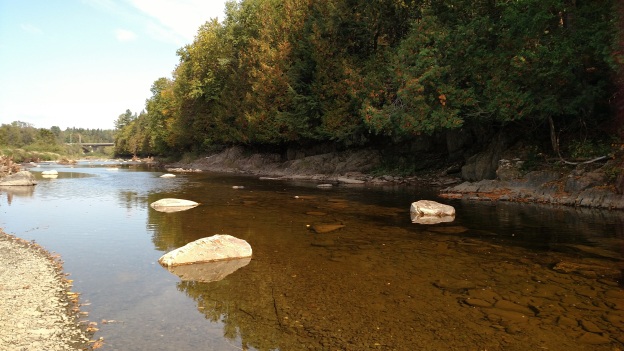This blog is the second in a series written by Jr. Native American Liaison Zintkala Eiring to highlight our Tribal partners and the work they are doing to manage wildlife populations – in honor of National Native American Heritage Month.
The Houlton Band of Maliseet Indians are known by several names: “Wolastoqeqiyik”, the “People of the Beautiful, Flowing River” or the “Metahksonikewiyik”, the “People of the Meduxnekeag River”. The Houlton Band are ancestrally committed to conserving the native fish with whom they share their home in northern Maine. Traditionally, the Houlton Band crafted birch bark canoes to travel during spring, the spawning season for sea-run fish, within Saint John’s Watershed, known as “Wolastoq” to the Maliseet. Historically, Maliseet Native Americans occupied most of the eastern border between the U.S. and Canada. In fact, the Jay Treaty of 1794 established free border crossing for Maliseet people between the two countries. Currently, the Houlton Band of Maliseet Indians Tribal trust land is near the town of Houlton, Maine.

The sea-run fish of the Meduxnekeag are traditionally significant to the Houlton Band of Maliseet Indians, but due to several threats, the Atlantic salmon is now defined as an “at risk” species in the United States. In fact, the species is listed as Endangered within the Gulf of Maine’s Distinct Population Segment (https://www.fws.gov/fisheries/fishguide/atlantic_salmon.html). Photo Credit: Zintkala Eiring
One of the Houlton Band of Maliseet Indians’ effort toward protecting their traditional fish, is to improve fish passage enhancement around culverts in tributaries of the Meduxnekeag River, which is named for being “rocky at its mouth”. This project is funded by Tribal Wildlife Grant, administered by the U.S. Fish and Wildlife Service.
One of the individuals leading this effort is, Sharri Venno, the Environmental Planner for the Houlton Band of Maliseet Indians. She mentioned several impairments that are encountered by the Atlantic salmon and other native fish that travel and shelter within the Meduxnekeag River. For example, up until the 1970’s, the Meduxnekeag riverbed was used to transport logged trees down the river to for lumber and timber-related industries. This resulted in an unnatural habitat for spawning fish, with few resting sites and little habitat to escape predation. Additionally, the State of Maine still identifies the presence of DDT and mercury in Maine’s inland waters. Furthermore, the Mactaquac dam in Fredericton, New Brunswick, built in 1968, creates a major obstacle for spawning, migratory fish. Due in part to several consultations with Tribal Nations, the dam company agreed to dedicate $100 million to fish passage. The Houlton Band and other Maliseet First Nations continue to increase awareness about fish being trapped within the dam’s head-pond and the difficulty of upstream passage for fish. Currently, fish have to be captured below the head-pond and trucked upstream to artificially complete their sea-run fish passage, terming the phrase “trap and truck” for spawning fish.

Recently, the Houlton Band of Maliseet Indians Natural Resource staff learned that Atlantic salmon were found during a Canadian survey in Marven Brook, North Branch, and Hagerman Brook, which are all segments of the Meduxnekeag River near their Tribal trust land. Marven Brook was the most successful, with 16 fry and 2 parr sampled in August 2016, using electrofishing equipment, according to Cara O’ Donnell. The HBMI’s next project goal is to use Environmental DNA (eDNA) to have a greater understanding of the presence/absence of Atlantic salmon and other aquatic species in the Watershed, which is being done in collaboration with the U.S. Army Corp of Engineers. Pictured here: Atlantic salmon. Photo Credit: USFWS, Greg Thompson
Due to the efforts of the Tribe’s Natural Resources Department and funding from U.S. Fish and Wildlife Service, the Houlton Band of Maliseet Indians have also improved 2 miles of the Meduxnekeag Main Stem, over 1 mile of the North Branch, and 100 feet of Pearce Brook, an upstream tributary and fishing location. HMBI has also placed large boulders and trees within the river system to replicate natural habitat structures that would have been in the river before the timber industry removed them in Maine.

The goal of placing pooling structures is to provide resting spots for spawning fish swimming upstream the Meduxnekeag River. Sharri Venno imagines the new habitat structures will help narrow and deepen the stream like it was naturally. Photo Credit: Zintkala Eiring

The Houlton Band of Maliseet Indians have been passionate advocates for the conservation of native fish, and have been heavily involved in the protection and recovery of sea-run fish. Several agencies have partnered with Maliseet Tribes through the signatures of several U.S. Federal Agencies (including the U.S. Fish and Wildlife Service) and Canadian Departments on the “Welastekw River Interim Statement of Cooperation” The document may be viewed here: Final Signed Statement of Cooperation 2017 Photo Credit: Zintkala Eiring
The conservation story of the Atlantic salmon is one of adaptability, perseverance, and pure passion and cultural attachment by the Houlton Band of Maliseet Tribe. Maliseet Nations have been sustainably harvesting sea-run fish for thousands of years. And today, they are at the heart of returning them to the Meduxnekeag River.
The Fish Enhancement Project was made possible by the dedication and efforts of the Houlton Band of Maliseet Indians and the Tribal Wildlife Grant program of the U.S. Fish and Wildlife Service. Grants are funded through an annual appropriation from the Land and Water Conservation Fund. For more information on the program, please view this website: https://www.fws.gov/nativeamerican/grants.html














